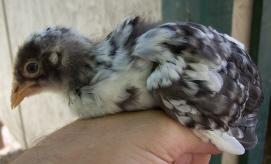Wait... is there any reason you're not interested in golden cuckoo Marans? Autosexing, dark egg layers. It would be a much shorter trip to select a line of those for laying and smaller size than the route you're talking about.
I would not mess with rose comb Brown leghorns, personally. I don't know of any production focused lines. They are fairly average layers, and much smaller eggs, too.
If you really want to "breed your own" just get a wheaten ameraucana roo over your existing flock of barred rocks and follow the chart, also selecting for peacombs. You'll have interesting olive/greenish hued eggs to boot.
I'm planning to do this For fun in bantam size after I track down some good quality wheaten ameraucana bantams and Dominique bantams.
I would not mess with rose comb Brown leghorns, personally. I don't know of any production focused lines. They are fairly average layers, and much smaller eggs, too.
If you really want to "breed your own" just get a wheaten ameraucana roo over your existing flock of barred rocks and follow the chart, also selecting for peacombs. You'll have interesting olive/greenish hued eggs to boot.
I'm planning to do this For fun in bantam size after I track down some good quality wheaten ameraucana bantams and Dominique bantams.


